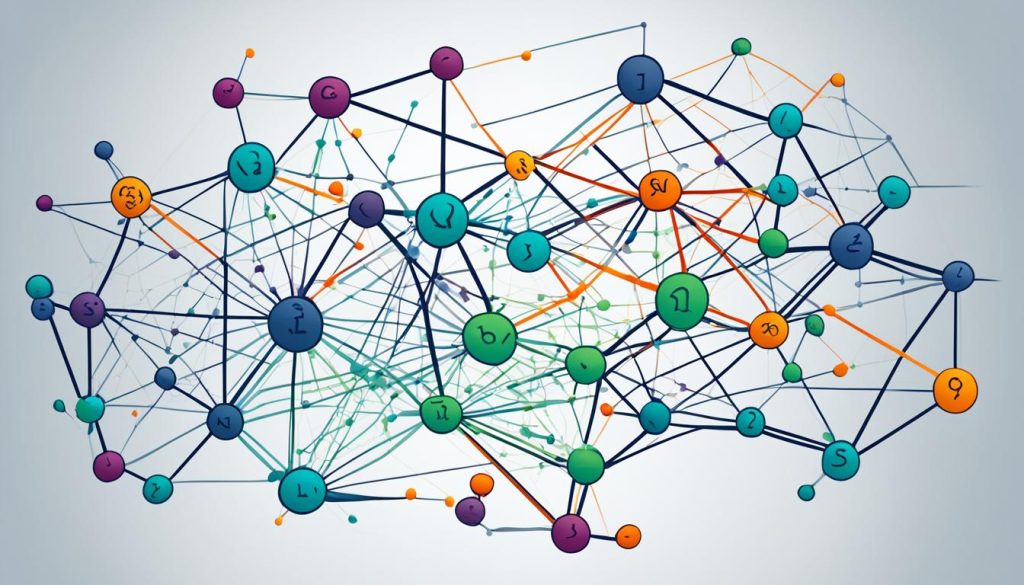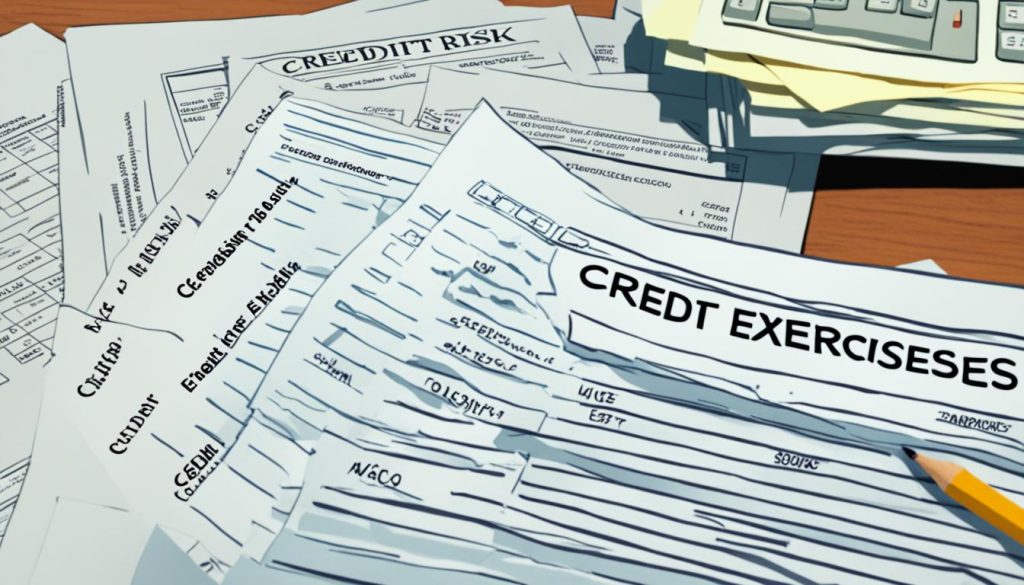Managing credit risk well is key to success in banking and lending. With 76% of traditional banks worried about new fintech threats1, having a strong credit risk plan is vital. By knowing how to manage credit risk and using best practices, you can make your lending better, cut down on losses, and make your company more stable financially.
At the core of managing credit risk is figuring out if borrowers can pay back loans. New tech like machine learning and AI has changed this by letting lenders use more data, like social media and transaction records2. This has made lending decisions better, improved how accurate they are, and helped group risks better2.
Learning the “Five Cs of Credit” – character, capacity, capital, collateral, and conditions – helps you understand borrowers’ finances and if they can pay back loans1. Using risk-based pricing, where you charge more to those at moderate risk, can also help reduce losses and improve your risk management1.
Key Takeaways:
- Effective credit risk management is essential for financial institutions to navigate the evolving landscape of financial services.
- Advances in technology, such as machine learning and AI, have revolutionized credit risk assessment by enabling the integration of diverse data sources.
- Understanding the “Five Cs of Credit” is crucial for comprehensive borrower evaluation and effective credit risk management.
- Risk-based pricing strategies help lenders mitigate potential losses and enhance their credit risk management practices.
- Comprehensive credit risk management practices can optimize cash flow, enhance financial stability, and minimize losses for financial institutions.
Understanding the Credit Risk Management Process
Learning how to manage credit risk is key for banks. It helps them figure out if borrowers will pay back their loans. They look at the borrower’s finances, credit history, and other factors3.
What is the Credit Risk Management Process?
Banks use the credit risk management process to check and lower lending risks3. It’s about making sure lending is profitable and safe for the bank3.
They check how likely a borrower is to pay back, watch their finances, and manage risks. Doing this well makes banks more trusted and attracts more customers3.
Why is Credit Risk Management Important?
It’s vital for banks to manage credit risk well. This protects them from loan defaults3. By knowing if a borrower can pay back, banks can make smart choices and avoid big losses3.
Good credit risk management also helps the whole financial system stay stable3. It stops widespread defaults and keeps the credit market working well3.
Research shows that 76% of traditional banks worry about new fintech companies4. But using AI and machine learning in credit risk can make risk assessment better and improve decisions4.
| Credit Risk Management Techniques | Description |
|---|---|
| Credit Risk Assessment | Looking at a borrower’s finances, credit history, and plans to see if they can pay back. This includes giving risk ratings and watching how borrowers do3. |
| Credit Scoring Models | Using math models to guess if a borrower will default. They look at credit history, payment habits, debts, and financial info3. |
| Portfolio Management | Spreading out lending to different borrowers and areas to lower risks3. |
| Loan Documentation | Creating clear loan agreements with all the details to avoid disputes and legal issues3. |
| Collateral Management | Using assets to secure loans, checking their value, and keeping an eye on them to reduce losses3. |
| Stress Testing | Seeing how loans would do in tough economic times to plan better and manage risks3. |
Understanding credit risk management and using best practices helps banks make smart lending decisions. This keeps the financial system stable3.
Key Aspects of Credit Risk Management
Managing credit risk is key for any group that lends money to people or businesses. It includes checking creditworthiness, evaluating loans, and looking at borrower reliability. It also means using strategies to lower risk and preventing fraud5.
Checking creditworthiness means looking at a borrower’s finances, credit score, and stability. It helps figure out if they can pay back the loan6. Looking at the loan itself, like its purpose and how it will be paid back, helps understand the risks6. It’s also vital to see if the borrower is reliable by checking their payment history and other factors6.
Using strategies to lower risk, like setting limits and asking for collateral, can help prevent defaults5. Protecting against fraud with strong security and detection systems keeps money safe from scams5.
Using technology is key for a quick and effective credit process. It lets us watch risks closely, sign up customers fast, and manage credit risks better, which makes finances more stable5. Keeping an eye on important numbers like days sales outstanding (DSO) and average days delinquent shows how well a company handles credit and runs efficiently5.
| Key Aspects of Credit Risk Management | Description |
|---|---|
| Creditworthiness Evaluation | Analyzing a borrower’s financial history, credit score, income stability, and other factors to determine their ability to repay a loan. |
| Loan Evaluation | Reviewing the loan’s purpose, amount, collateral, and repayment plan to understand the associated risks. |
| Borrower Reliability | Evaluating the borrower’s trustworthiness, payment history, and other reliability factors to make informed credit decisions. |
| Credit Risk Mitigation | Implementing strategies, such as setting credit limits and requiring collateral, to reduce the likelihood of loan defaults. |
| Fraud Prevention | Establishing strong security protocols and fraud detection systems to protect against financial losses due to fraudulent activities. |
By focusing on these key areas, organizations can improve their financial health, lower risks, and make better lending choices567.
“Effective credit risk management is the cornerstone of a healthy lending portfolio and long-term financial success.”
Best Practices for Managing Credit Risks
Credit Risk Management Techniques
Managing credit risks well is key to staying financially stable and profitable. Lenders can use different methods to lower risks and keep their loan portfolios healthy8. First, they need to deeply understand the borrower’s creditworthiness. This means looking at the “Five Cs of Credit”: character, capacity, capital, collateral, and conditions9.
To reduce risk and boost profits, lenders should always check their data and make sure their scorecard models are correct8. Using the latest technologies like AI and machine learning helps them stay ahead of new credit risks8. It’s also vital to be ready for financial crimes and have accurate, easy-to-get data for good credit risk management9.
With the rise of fintech and changing economic conditions, lenders face new challenges8. Keeping an eye on credit risks in real-time can help spot and fix problems early8. Having a strong credit policy is key for businesses to handle financial risks and deal with customers who can’t pay back10.

By following best practices in credit risk management, lenders can handle the changing credit scene. They can protect their portfolios and stay financially stable over time8109.
Effective Methods for Managing Credit Risks
Advantages & Disadvantages of Credit Risk Management
As a lender, you have many ways to handle credit risks. One good method is risk-based pricing, where those seen as moderate risk pay more interest11. Also, regular MIS reporting lets you keep an eye on your borrowers’ finances and how they pay back11.
Having a strong credit risk management framework brings many benefits. It lets you deeply analyze credit, diversify your portfolio, and keep track of borrowers’ credit status11. But, this method also has its downsides, like poor data handling, lacking infrastructure, and bad reporting and visualization11.
Stress testing your credit portfolio shows how it might do in tough economic times11. It’s key to have a clear credit risk management policy with strict rules and controls for good risk handling1112.
| Advantages of Credit Risk Management | Disadvantages of Credit Risk Management |
|---|---|
|
|
Good credit risk management is vital for lenders to cut losses, keep customer trust, and follow the rules12. By using the right strategies and methods, you can overcome the challenges and enjoy the perks of being proactive in credit risk management.

“Establishing a robust credit risk management framework is key to navigating the complexities of the lending landscape.”
How Do Banks Manage Credit Risk Manuals?
Managing credit risk is key for banks to stay stable and profitable. At the heart of this is credit risk modeling. It uses data to guess how likely borrowers are to default and the effect on the bank13. Banks use big data analytics to improve their credit risk checks. This helps them decide on loans and interest rates better13.
The Federal Reserve guides banks on handling credit risk well. This includes managing risks from other parties, offering small loans wisely, and using the Current Expected Credit Losses (CECL) method14. Banks also have their own credit risk ratings to see how likely borrowers will pay back, as seen in the Bank Holding Company Supervision Manual15.
To keep credit risk under control, banks must watch their risks closely. They need to check their exposure to different types of risk14. By being proactive in managing credit risk, banks can handle the financial challenges better and keep their portfolios healthy15.

| Regulatory Guidance | Focus Area |
|---|---|
| SR 11-14 | Agricultural credit risk management |
| SR 20-10 | Credit risk review systems |
| SR 20-13 | Responsible small-dollar lending |
| SR 19-8 | CECL methodology |
| SR 16-17 | Risk management of reserve-based energy lending |
“Well-managed credit risk rating systems promote bank safety and soundness.”15
Technology in Credit Risk Analysis
The world of credit risk management has changed a lot thanks to technology. Data analytics and machine learning have changed how companies check creditworthiness and manage risks. These tools help make quicker, more accurate credit decisions. This helps businesses deal with default risk, credit spread risk, and concentration risk better.
Types of Credit Risk
Companies need to understand different credit risks to make smart credit decisions. Default risk is when a borrower can’t pay back their debt. Credit spread risk is about changes in interest rates between bonds. Concentration risk happens when a company’s money is mostly tied up in one borrower, industry, or area16.
To handle these risks, companies use data analytics and machine learning. These technologies help them make quicker, more precise credit decisions. This reduces their financial risks and makes them more stable1617.
Technology has a big impact on managing credit risk. By using data analytics and machine learning, companies can deal with credit risk better. This ensures they stay financially stable in the long run1617.
“Gen AI technology from OpenAI acquired over 100 million users within two months of its public beta launch, and credit risk executives believe gen AI will be part of their companies’ credit risk processes within two years.”
As the financial world changes, using technology in credit risk analysis will be key for businesses. It will help them succeed in a tough and changing market1617.
credit risk exercises
To manage credit risks well, banks must do credit risk exercises often. These exercises help them stress test loans, check credit risk models, and look at concentration risks. By doing these, banks can better handle credit risks, make smarter lending choices, and keep their credit portfolios healthy18.
Scenario analysis is a key exercise where banks test their loans against different economic and market conditions. This helps them find weak spots and plan for tough times18. Model validations are also key to make sure credit risk models, like the Merton model, are right and reliable18.
Another important exercise is concentration risk assessment. Banks need to look at their risk in certain sectors, borrowers, or areas to avoid too much risk18. They check credit spreads, time to maturity, and interest rates to understand credit spread better18. By spotting and fixing these risks, banks can keep their portfolios diverse and reduce risk18.
These exercises, along with knowing about credit risk modeling, help banks make better lending choices and manage their risks well18. Using best practices in credit risk management helps banks deal with the complex financial world and grow over time18.
“Proactive credit risk management, through exercises like stress testing and model validation, is essential for financial institutions to maintain a healthy, resilient loan portfolio.”
By doing credit risk exercises often and keeping up with new modeling methods, banks can handle credit risks better and make smarter lending choices18. This leads to a stronger credit portfolio and more financial success18.
Other models like CreditRisk+, CreditMetrics, and the KVM model also help assess credit risk. They have different assumptions and outputs, giving banks various tools to manage their risks18.
Also, banks must think about the risks from derivatives and counterparty risk19. Derivatives can have their own risks, and banks need to consider these before using them19. By staying alert and including these risks in their plans, banks can better handle the complex credit world18.
- Do regular scenario analyses to test the loan portfolio and find weak spots.
- Check credit risk models, like the Merton model, to make sure they’re accurate.
- Look at concentration risks in the credit portfolio to avoid too much risk.
- Keep up with the latest in credit risk modeling, including CreditRisk+, CreditMetrics, and the KVM model.
- Consider the risks from derivatives and counterparty risk in managing credit risk.
By actively doing these credit risk exercises, banks can better manage their risks, make smarter lending choices, and keep their credit portfolios healthy18. This helps the bank stay stable and successful over time18.
| Credit Risk Management Technique | Description |
|---|---|
| Scenario Analysis | Stress testing loan portfolios against various economic and market conditions to identify vulnerabilities and develop mitigation strategies. |
| Model Validation | Ensuring the accuracy and reliability of credit risk models, such as the Merton model, to enhance decision-making. |
| Concentration Risk Assessment | Analyzing exposure to high-risk sectors, borrowers, or regions to prevent over-concentration and potential losses. |
| Counterparty Risk Management | Incorporating the impact of derivatives and counterparty risk into the credit risk management framework. |
By adding these credit risk exercises to their risk management plan, banks can handle the complex credit world with confidence and achieve long-term success18. A mix of proactive risk management, strong modeling, and understanding credit risk can keep a bank’s credit portfolio healthy and diverse in a changing financial world18.
Conclusion
Managing credit risk well is key for keeping finances stable and profitable in lending20. By knowing how to manage credit risk, using best practices, and technology, lenders can better check borrowers’ credit and make smart lending choices21. Keeping an eye on things, using data, and having a strong risk management plan are vital for success in today’s changing credit world22. A strong focus on credit risk management shows a financial institution is well-run and strong.
Using strategies like stress testing helps lenders see and handle credit risks20. By checking their own capital and watching market risks, lenders can spot and fix big risks. This keeps them financially stable21. Also, using technology and data can give lenders important insights to improve credit decisions and manage their portfolios better22.
The need for strong credit risk management grows as rules change and markets shift. Banks that focus on this area will be ready for the future. They can protect their assets and find new chances for growth and success202122.
FAQ
What is the credit risk management process?
The credit risk management process looks at a borrower’s finances and history. It checks their income and past borrowing and payment history. This helps lenders understand the risk of lending to someone and make smart decisions.
Why is credit risk management important?
It’s key for banks and lenders to reduce risks and make more money. It helps them avoid defaults and keep their credit portfolios healthy. For borrowers, it means getting loans they can handle and improving their credit scores.
What are the key aspects of credit risk management?
Key aspects include checking how creditworthy a borrower is, evaluating loans, and assessing how reliable a borrower is. It also involves strategies to reduce risks and prevent fraud. These steps help lenders understand and manage risks better.
What are the best practices for managing credit risks?
Best practices include using the “Five Cs of Credit” to evaluate borrowers. It’s also important to regularly check scorecard models and use AI and machine learning. Having a clear credit policy is also crucial.
What are the advantages and disadvantages of credit risk management?
Advantages include thorough credit analysis and managing risks well. However, it can be hard to manage data, lack infrastructure, and have poor reporting. A strong framework with clear policies is needed for effective management.
How do banks manage credit risk?
Banks use credit risk modeling and advanced analytics to better understand risks. They follow the Federal Reserve’s guidelines, like handling counterparty credit risk and lending responsibly. Banks also use the Current Expected Credit Losses (CECL) method and their own credit risk ratings to manage risks.
What are the different types of credit risk?
Credit risk includes default risk, credit spread risk, and concentration risk. Default risk is when a borrower can’t pay back. Credit spread risk is about interest rates changing. Concentration risk is when a company has too much money in one place.
What are credit risk exercises?
Credit risk exercises help financial institutions improve their risk management. They include scenario analyses, model validations, and concentration risk assessments. Doing these exercises helps banks make better lending decisions and keep their credit portfolios healthy.
Source Links
- Credit risk processes
- Credit Risk Models with Machine Learning
- Credit Risk Management Best Practices
- Credit Risk Management Process, Best Practices & Techniques In Banks
- 6 Key Credit Risk Mitigation Strategies
- Credit Risk Management: Challenges and Best Practices
- The six elements for a successful credit risk management | ACTICO Blog
- Best Practices And Strategies For Managing Credit Risk
- A Guide To Managing Credit Risks For A Strong Bottom Line
- 7 tips for effective credit management and avoid business risks | Coface
- Principles for the Management of Credit Risk
- Strategies for Effective Credit Risk Management in Banks
- Credit Risk: Risk Management of Loan Purchase Activities
- The Fed – Supervisory Policy and Guidance Topics
- Rating Credit Risk
- Embracing generative AI in credit risk
- Transforming Credit Risk Management: The Impact Of AI And ML – Avenga
- Credit Risks and Credit Derivatives | FRM Part 2 – AnalystPrep
- How to Quantify Credit Risk
- Capital adequacy for Credit Risk: a practical exercise
- Credit Risk Analysis
- The Credit Analyst | FRM Part 2 Study Notes – AnalystPrep

